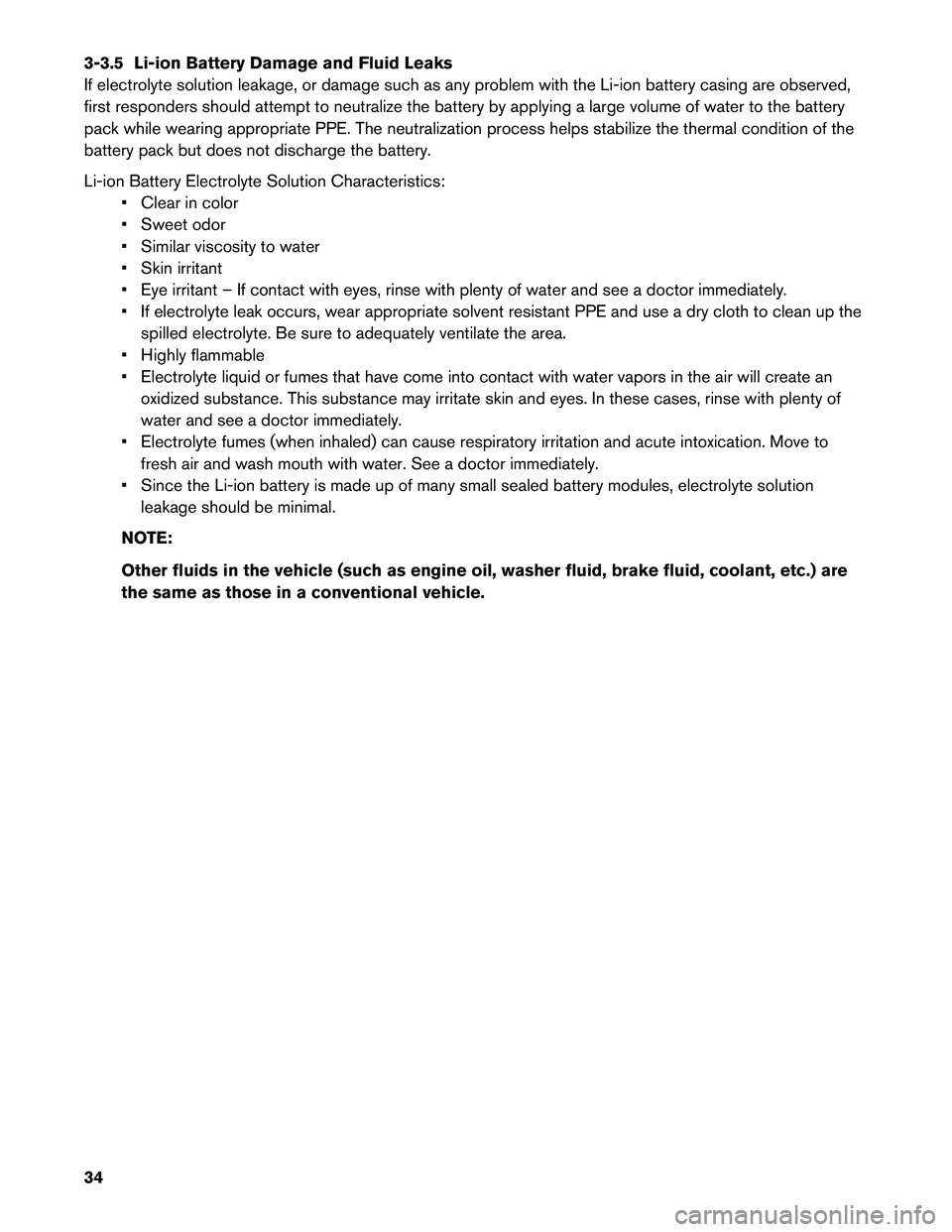1. Crash zone sensor
2. Supplemental front air bag
modules (INFINITI Advanced Air
Bags) 3. Front seat-mounted side-
impact supplemental air bags
4. Occupant classification sensor
(pattern sensor) 5. Occupant classification system
control unit6. RH seat belt with pretensioner
7. Roof-mounted curtain side-
impact supplemental air bags 8. Roof-mounted curtain side-
impact supplemental air bag infla-
tors9. RH satellite sensor
10. Air bag control unit (ACU) 11. LH seat belt with pretensioner 12. LH Satellite sensor
13. Lap outer pretensioner (if so
equipped) 14. Front door satellite sensor LH
(RH similar) AAYIA0020ZZ
31
3-3.5 Li-ion Battery Damage and Fluid Leaks
If
electrolyte solution leakage, or damage such as any problem with the Li-ion battery casing are observed,
first responders should attempt to neutralize the battery by applying a large volume of water to the battery
pack while wearing appropriate PPE. The neutralization process helps stabilize the thermal condition of the
battery pack but does not discharge the battery.
Li-ion Battery Electrolyte Solution Characteristics: • Clear in color
• Sweet odor
• Similar viscosity to water
• Skin irritant
• Eye irritant – If contact with eyes, rinse with plenty of water and see a doctor immediately.
• If electrolyte leak occurs, wear appropriate solvent resistant PPE and use a dry cloth to clean up thespilled electrolyte. Be sure to adequately ventilate the area.
• Highly flammable
• Electrolyte liquid or fumes that have come into contact with water vapors in the air will create an oxidized substance. This substance may irritate skin and eyes. In these cases, rinse with plenty of
water and see a doctor immediately.
• Electrolyte fumes (when inhaled) can cause respiratory irritation and acute intoxication. Move to fresh air and wash mouth with water. See a doctor immediately.
• Since the Li-ion battery is made up of many small sealed battery modules, electrolyte solution leakage should be minimal.
NOTE:
Other fluids in the vehicle (such as engine oil, washer fluid, brake fluid, coolant, etc.) are
the same as those in a conventional vehicle.
34
3-3.6 Accessing the Occupants
1. Remove windowsa. Perform window removal the same as a normal vehicle.
2. Remove doors a. The doors are removable with hand tools or basic rescue tools such as electrical/hydraulicrescue tools. It may be easier to remove the doors by cutting door hinges.
3. Adjust steering wheel and front seat position (if necessary) as shown below:
4. Remove front seat head restraint (if necessary) .
The front seat head restraint can be removed by
pressing the lock knob and pulling it up.
5. Unfasten the seat belt. Seat belt can be unfastened by pressing the release
button. If seat belt cannot be unfastened, cut it with
a belt cutter. AAYIA0078ZZ
AAYIA0079ZZ
AAYIA0080ZZ
35



















